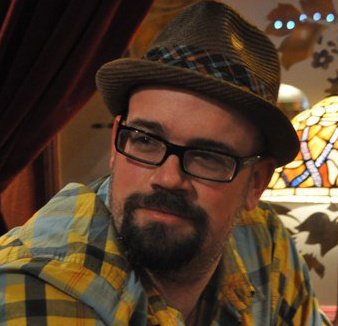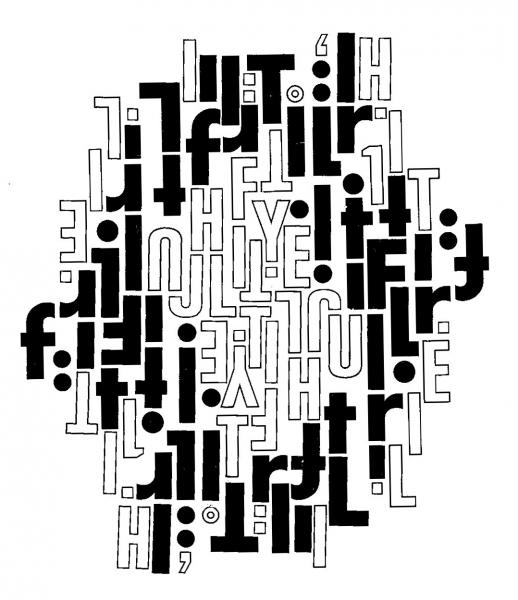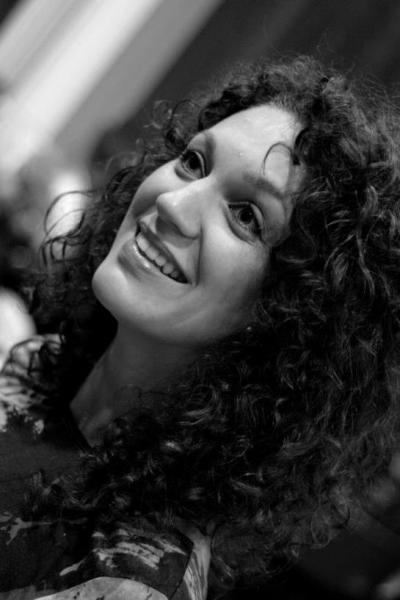Conceptualist ostranenie: A dialogue between Derek Beaulieu (Canada) and Natalia Fedorova (Russia)
10 August 2012

The following is an occassional dialogue composed for this occassion. Derek Beaulieu and Natalia Fedorova may not have met apart from the artifice of this conversation. Nonetheless, there is a conceit of some commonality of interest and points of divergence. This is part two of the series.
Derek Beaulieu Both my concrete poetry and my conceptual writing focus on distancing myself from subjective representation. I am fascinated by Place and Fitterman’s idea of the Sobject and by Goldsmith’s proclamation that “I am interested in subjectivity, just not my own.” Goldsmith argues that Conceptual writing is only the 2nd truly international writing movement, coming approximately 50 years after the formulation of Concrete Poetry.
Natalia Fedorova Sobjectivity translated into the post-soviet reality will read: “re-politicization of the form” as a key tendency in reanimating conceptualist ostranenie of the language from the official propaganda. History is recycling itself in the absurd Kafka-esque Pussy Riot trial that calls for the same methods today as in the Soviet times.

Frighteningly similar insipid discourse of the official media requires the rigour of conceptualist action (not accidentally Judge Surova doesn’t allow laughter in the court room, and people who laugh or smile are expelled immediately by the officers). Indeed, in the age of twitter and Facebook revolutions, an idea implemented into action, a catchy internet meme can be as important in mobilizing the human force, as military power. Laboratory of Poetry Actionism, a workshop of poets, artist and philosophers from St-Petersburg, recently became famous for the authorship of the after December parliamentary elections protests' slogan: «Vy nas dazshe ne predstavliaete» (“You don't even represent us/You cannot even imagine us”), alluding to both absence of representational democracy and the changes that are about to happen in Russia. According to Susan Moore, “Pussy Riot are essentially conceptual artists. This is what makes them threatening—it is not possible to imprison a concept.”

One of the main goals of the communist revolution was the establishment of equality not only between rich and poor, or between men and women, but also between subject and object. Subject-object relationship is rooted in the exchange and property. The subject-object border had to be eliminated through the “re-education” of the artwork so it would acquire a “conscience,” become a non-alienated subjectivity, a “comrade-thing.”[1] In The Communist Postscript Groys explains:
"In Soviet communism, every commodity became an ideologically relevant statement, just as in capitalism every statement becomes a commodity. One could eat communistically, house and dress oneself communistically—or likewise non-communistically, or even anti-communistically. This meant that in the Soviet Union it was in theory just as possible to protest against the shoes or eggs or sausage then available in the stores as it was to protest against the official doctrines of historical materialism."
It probably can be said that Moscow conceptualism had to deal with already conceptualized reality. When Western conceptualism takes objects from reality and turns them into art, Moscow Conceptualism steps out into something other than art: the Soviet socialist reality.
In modern “capitalist” Russia the aim of Laboratory of Poetic Actionism is again “reverse alienation from daily routine by filling the city space with poetry”[2], embodying the protest energy of the left movement in slogans and poems, or slogans of poems that could become political actions as read by people in the street.
Derek Beaulieu Both Eugen Gomringer & Mary Ellen Solt sought simplicity & clarity in their materialist use of semantic particles (Gomringer’s “Silencio” & Solt’s “Flowers in Concrete” are examples). Gomringer argues that concrete poetry is an essentially modernist gesture that “realize[s] the idea of a universal poetry” & can “unite the view of the world expressed in the mother tongue with physical reality.” His poetic is created by a dictatorial author-function, the modernist concrete poem limits & sanctions the role of the reader according to strict formulations; the reading space is “ordered by the poet […h]e determines the play-area, the field or force & suggests its possibilities.” Writing in 1954, Gomringer argued for a poetic which both reflects & augments commercial advertisements & graphic design, “[h]eadlines, slogans, groups of sounds & letters give rise to forms which could be models of a new poetry just waiting to be taken up for meaningful use […] So the new poem is simple & can be perceived visually as a whole as well as in its parts.” Gomringer proposes that “languages are on the road to formal simplification; abbreviated, restricted forms of language are emerging.”
Natalia Fedorova In Communist Postscript Groys mentions linguistification of the society, where it is transcribed from the medium of money into the medium of language. Surrounded by texts of propaganda, Moscow conceptualists such as Erik Bulatov and Dmitry Alexandrovich Prigov used the same slogans and banners for their work.

“Vy nas daje ne predstavliaete” not only made the LPA famous, but also kindled the “Slogan” (1977), one of Moscow conceptualist’s Collective Actions,[3]which involved a red banner hung between trees on a hill in the countryside near Moscow; the slogan read: “I do not complain about anything and I almost like it here, although I have never been here before and know nothing about this place” (a quote from Andrei Monastyrski’s book Nothing Happens).

Lots Letters is an installation re-politicizing Vsevolod Nekrasov’s poem But you know what [4] first published in 1989. Each letter of the poem is cut out of foam plastic, attached with the help of wire to the sides of trees so that the viewer can walk in the space of lines. Lots of Letters embodies topical for the present and symptomatical for the underground cultures notion of absence of representation.

Derek Beaulieu This reduction & “simplification” of language—this attempt to create a universal poetic based on headlines & slogans—is now completely submerged into contemporary graphic design & advertising. In many ways Gomringer was correct, poetry today must learn from the insightful use of language which is typified by contemporary graphic design and advertising. Marjorie Perloff states, “this call for what Eugen Gomringer has characterized as ‘reduced language’ for ‘poems […] as easily understood as signs in airports & traffic signs,’ runs the risk of producing poems ‘poems’ that are airport & traffic signs.” We should be so lucky.
My own concrete poetry is dedicated to the exploration of dry-transfer lettering. Once ubiquitous in business and graphic design environments, dry-transfer lettering (and its largest manufacturer, Letraset) is now an antiquated cultural artifact denigrated to artist production. Only once the business community rejected Letraset in favour of computerized graphic design technologies did dry-transfer lettering enter an artistic vocabulary. Ironically, that transition only occurred once the medium was deemed not cost effective by its manufacturers and is slipping out of production. I view poetry, as typified by concrete poetry, as the architectural structuring of the material of language; the unfamiliar fitting together of fragments, searching for structure.
Mine is a poetic without direct one-to-one signification. It is rhizomatic in composition, pointing both to & away from multiple shifting clouds of meanings and construction, where writing, as Deleuze & Guattari said “has nothing to do with signifying […] it has to do with surveying [and] mapping.” This rhizomatic writing is “a map not a tracing”; and as a map it has multiple entryways, as opposed to the tracing, which always comes back to the ‘same.’ The map has to do with performance, whereas the tracing always involved an alleged ‘competence.’ The writing I foreground in these “multiple entryways” is that which focuses on excess—the leftovers, the refuse, the waste. Writing which overflows the container of the poetic.
I construct my poems without an architectural plan or previous sketch, allowing the work to build gesturally in response to shapes and patterns in the letters themselves. Poems are constructed one letter at a time, each placed by hand. Once fastened to the page the dry-transfer letters are permanently affixed and cannot be erased or removed. A physical embodiment of Allen Ginsberg’s dictum extolling “first thought, best thought.” I attempt to craft my work with an eye to graphic design and typography—a poetry that looks to the evocative potentialities of kerning, letter-spacing, x-height and ascenders. The resultant poems, if executed with the same care given to projects by the best graphic designers, are logos and slogans for 'pataphysically impossible businesses.
Natalia Fedorova LPA use reflective medium of video to interpret Vsevolod Nekrasov and Andrey Monastirsky’s work can be compared to the work of translation, where the author remains the author and the translator owns something in between the languages, not fully the end result, certainly, not the original text. Owning no text but its differential qualities, the videopoet’s work nevertheless allows for the simultaneity of impression and expression.
The imagetext also requires different vreading (viewing and reading), as much as the textual installation requires wreading (walking and reading) or haptic interactive media asks for treading (touching and reading). A documented textual installation such as “” requires vreading and imagining how the wreading could feel. As Vanessa Place puts it, “that is to say, the saving grace of the promise of life after life, of Zombie poetries.”[5]
“Dotted Line Composition (with pictures)” was thought by Andrey Monastirsky as a performance, in which the guests (mostly artists) were invited to listen to the text of "Stimmung" read by the author and then, on the handed out sheets of paper, during the reading of “Pictures”("Kartinki"), quickly draw in any style the images that reflect the text read. There was a five minute pause between readings of the “Pictures”[6], which seems to be comparable to the time it took Dina Gatina and Pavel Arseniev to arrange the scene for each shot. Andrey Monastirsky writes that this performance only took place once in December of 1973[7], but now we probably can state that it was two times at least.




Derek Beaulieu Advertisers and graphic designers use the fragments of language to fully realize emotional, social and political means—and in doing so have left poets with only the most rudimentary tools in doing the same; the ‘golden arches,’ the Nike ‘swoosh’ and the Dell logo best represent the contemporary descendants of the modernist poem. Poet Lew Welch famously wrote the ubiquitous Raid slogan “Raid kills bugs dead” as a copywriter at Foote, Cone & Belding in 1966. Vanessa Place argues, “we are of an age that understands corporations are people too and poetry is the stuff of placards. Or vice versa.” Like logos for the corporate sponsors of Jorge Luis Borges’ library, my concrete poems use the particles of language to represent and promote goods and corporations just out of reach. These imaginary businesses, and the advertising campaigns that support them, promote a poetic dreamscape of alphabetic ostranenie.
These texts are, as bpNichol said, “pulled off the page even as [it] disintegrate[s], a double thrust of text into silence.” In my own practice concrete poetry is not a score for oral performance and is not meant to be articulated in sound. This “double thrust of text into silence” then becomes another issue of the rejection of exchange in concrete poetry. While the concrete poet cannot control how the reader will approach—or even perform a text—it is my aim to step away from performance of these poems in order to further complicate the exchange value of poetry. While ‘value’ and ‘commodity’ are never completely escaped, its transferal can be troubled by the removal of the verbal from the communication equation:
"Communication ‘occurs’ by means of a sole instantaneous circuit, and for it to be ‘good’ communication must take place fast—there is no time for silence. Silence is banished from our screens; it has no place in communication. Media images […] never fall silent: images and messages must follow one upon the other without interruption. But silence is exactly that—a blip in the circuitry; a minor catastrophe, a slip which […] becomes highly meaningful—a break laden now with anxiety, now with jubilation."
Derrida, writing on Blanchot, asked “How can one text, assuming its unity, give or present another to be read, without touching it, without saying anything about it, practically without referring to it?” Each page of my graphically-realized Flatland is a completely unique, diagrammatic representation of the occurrences of letters. By reducing reading and language into a paragrammatical statistical analysis, content is subsumed into graphical representation of how language covers a page. In his famous defense of Joyce’s Work in Progress, Samuel Beckett argued that “[h]ere is direct expression—pages and pages of it” chiding the reader that “[y]ou are not satisfied unless form is so strictly divorced from content that you can comprehend the one almost without bothering to read the other.” Beckett’s defense of Work in Progress is temporally adaptable to become a slogan for conceptual work in general “[h]ere form is content, content is form [.…] this stuff is not written in English. It is not written at all. [… this] writing is not about something; it is that something itself.”
[1]Degot, Ekaterina. Performing Objects, Narrating Installations: Moscow Conceptualism and the Rediscovery of the Art Object. E-flux # 29, 2011.
[2]"About the Laboratory”. 1 March 2012. http://poetryactionism.wordpress.com/
[3](Collective Actions). Descriptions, photos, video, and audio of all actions: MANI Archive.
http://conceptualism.letov.ru/?KD-ACTIONS.html
вut you know
what
do excuse me
you don't know
you
wouldn't like to know
you wouldn't go
around pulling your
own leg
you
don't know us
but you need
to not know us
we can't be known
you can't know us
we need to not be known
I don't know
what else I can
tell you here
more importantly
what can I
do for you
here
http://poetryactionism.wordpress.com/2012/07/10/основной-проект-iii-международной-биенн/
[5]Place, Vanessa. “Zombie Poetry”
[6]Monastirsky, A. “Dotted Line Composition”. 2001. 1 March 2010.
http://www.vavilon.ru/texts/monastyrsky1-3.html
[7]Ibid.
Derek Beaulieu is the author of five books of poetry, three volumes of conceptual fiction, over 150 chapbooks and one volume of criticism, Seen of the Crime, which was published by Snare Books in 2011. He is the youngest writer in Canada to have his papers collected in extensio by Simon Fraser University’s Contemporary Literature Collection and is the publisher of the acclaimed smallpresses housepress (1997–2004) and no press (2005–present). Beaulieu is the visual poetry editor at UBUWeb and teaches at the Alberta College of Art and Mount Royal University. In Fall of 2012 Bookthug is publishing his critical edition (co-edited with Gregory Betts) of bill bissett’s seminal 1972 volume of experimental commentary RUSH: what fuckan theory and in 2013 Wilfrid Laurier University Press is publishing his Writing Surfaces: The Selected Fiction of John Riddell (co-edited with Lori Emerson). 2013 also brings Wilfrid Laurier UP’s No more poetry, please: the selected poetry of derek beaulieu as edited by Kit Dobson and a new volume of visual poetry entitled Kern (Les Figues Press).
Natalia Fedorova is a new media artist, writer, literary scholar and translator. Natalia holds a PhD in literary theory from Herzen State University (St-Petersburg). She is an author of publications on avant-garde poetry, kitetic poetry, concrete poetry, hyperfiction, literary text generators and video poetry, as well as a curator and creator of VIDEO.txt, videopoetry festival in St- Petersburg. Natalia is an author of hyperfiction piece with multiple endings «7», and an interactive novel «Madame Ebaressa and a Butterfly», co-written with Sergeij Kitov, and a number of short prose fragments. In collaboration with Taras Mashtalir she founded Machine Libertine, a media poetry project («Snow Queen», «In Your Voice», «Machine Poetry Manifesto», «Whoever You Are», «Light Duty», «A Clock»). Currently Natalia is back after her one year postdoctorate term at MIT Trope Tank to teaching experimental literature in Smolny University (St-Petersburg) and editing of e-lit and new media writing column in Rattapallax magazine (NY).




Global conceptualisms